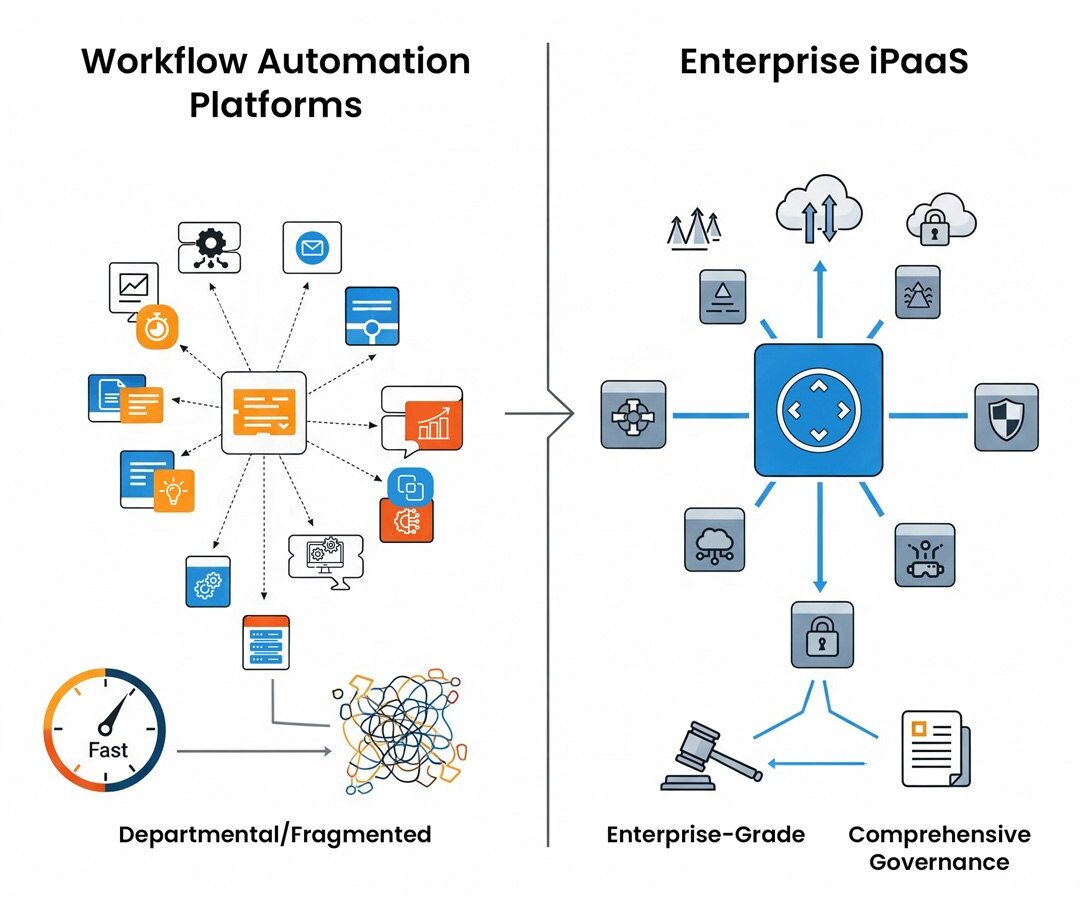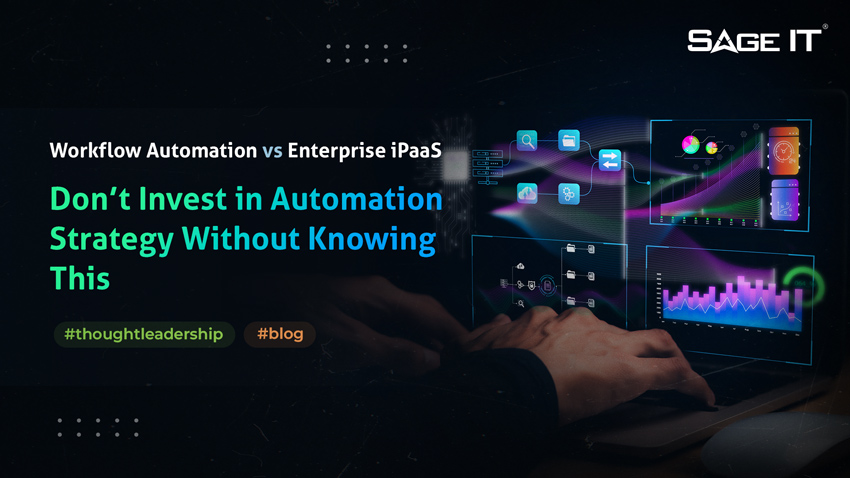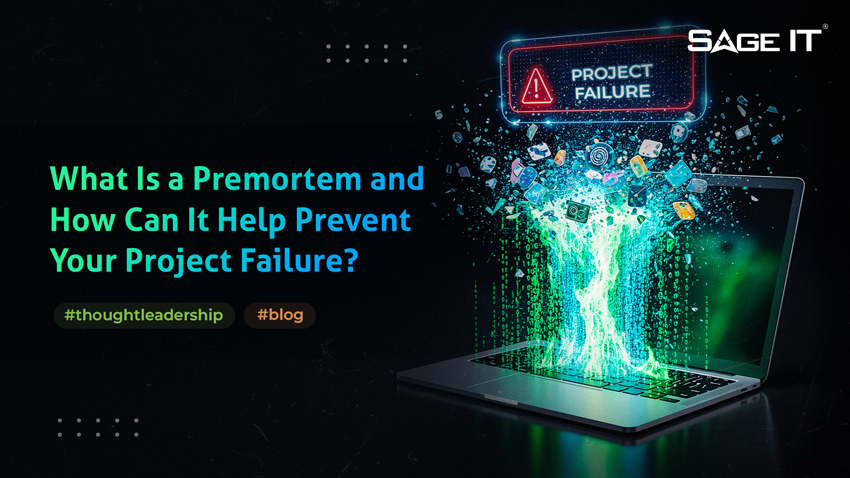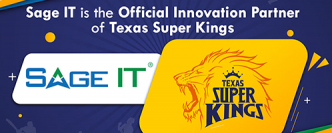Every business begins its automation journey with good intentions. A new app is connected to a spreadsheet. A form submission triggers an email. A Slack message alerts a sales rep about a new lead. At first, it feels like progress, fast, flexible, and frictionless.
But then complexity creeps in.
Multiple departments adopt their own tools. Integrations multiply in the shadows. What was once efficient becomes fragmented. Critical workflows fail silently. Data moves, but not securely or consistently. IT loses visibility. Teams spend more time managing automations than doing the work they were meant to automate.
This is the tipping point, the moment when your integration strategy stops being tactical and starts becoming strategic.
At this crossroads, leaders face a fundamental question:
Do we keep layering more workflow automation tools, or is it time to invest in something purpose-built for scale, governance, and growth?
In this guide, we’ll unpack the core differences between workflow automation platforms and enterprise iPaaS, and help you design an integration strategy that grows with your business.
Workflow Automation vs. Enterprise iPaaS: What’s the Difference?
When teams first look to automate business processes, workflow automation tools are often the go-to choice. They’re fast to implement, easy to use, and built for individual tasks, like sending a notification, updating a record, or syncing data between two SaaS apps.
These tools, like Zapier, Make, and n8n, use visual builders with drag-and-drop simplicity, making them ideal for non-technical users and small teams. Their real strength lies in improving personal or departmental productivity without needing IT involvement.
But here’s the catch: workflow automation platforms were never designed to manage enterprise-wide integration.
As organizations scale, their systems become more complex. You’re not just moving data, you’re transforming it, securing it, monitoring it, and ensuring it flows across departments, applications, and hybrid environments.
That’s where enterprise iPaaS (Integration Platform as a Service) comes in.
iPaaS platforms, like MuleSoft, Boomi, and Workato, go far beyond simple task automation. They’re built for IT teams and integration architects who need to connect diverse systems (cloud, SaaS, on-prem), enforce governance, and manage performance at scale.
Unlike workflow tools, iPaaS supports advanced capabilities like:
- API lifecycle management
- Real-time data streaming
- Transformation logic
- Centralized monitoring and compliance controls
Workflow automation helps you move fast. iPaaS helps you scale smartly.
Both play a role in the modern enterprise, but they solve very different problems.
The real decision isn’t about which one is better, it’s about knowing when your needs outgrow the other.
Workflow Automation vs. Enterprise iPaaS

Which One Is Right for You (and When?)
1. What is the complexity of your integration needs?
If you’re automating one-off actions, like logging a form submission into Google Sheets or sending alerts to Slack, workflow tools are a great fit. They’re quick, easy, and built for simple, event-based use cases.
But when your flows start pulling data from multiple systems, applying logic (like “if X, then Y”), or handling sequences with dependencies, you need more than simplicity.
That’s where enterprise iPaaS comes in. It handles:
- Multi-step workflows with data transformation
- System-to-system orchestration across cloud and on-premise apps
- Handling of API-based integrations at scale
If your automation logic needs more than a few drag-and-drop boxes, you’re likely ready for Enterprise iPaaS.
2. What is your team’s technical skill level?
Workflow automation platforms are designed for business users, people who understand the process but may not write code. These platforms offer visual builders and low-code interfaces to move quickly.
But as automations get more complex, they often require:
- Custom APIs
- Data validation rules
- Monitoring and alerting
- Rollback or retry mechanisms
If your integrations are becoming technical by nature, and your team includes developers or IT engineers, Enterprise iPaaS gives them the tools they need, without sacrificing control.
3. What are your data and security requirements?
For automating public data or SaaS-to-SaaS notifications, workflow tools may be enough.
But when you’re dealing with:
- Personally Identifiable Information (PII)
- Payroll or healthcare records
- Customer transactions or contracts
You need:
- Encryption
- Audit trails
- Compliance (GDPR, HIPAA, SOC 2)
Workflow automation platforms rarely offer this level of control. iPaaS platforms are built with governance in mind.
4. What is your scalability and future growth plan?
Workflow automation works great when you’re small. You can move fast and automate tasks without much planning.
But as your organization grows:
- You add more apps
- Teams build their own automations
- No one has full visibility
Soon, you’re stuck in what’s known as “integration sprawl.”
iPaaS brings centralized management, one place to see, control, and secure all integration flows.
Why Workflow Tools Break at Scale (And What It Costs You)
Every tool has limits. For many businesses, workflow automation platforms help kickstart progress, a few synced apps, a couple of alerts. But as integrations grow organically, cracks begin to show. The issue isn’t just automation, it’s how that automation fails when stretched.
Let’s explore the real risks companies face, and how they accumulate hidden costs over time.
1. Disappearing Visibility
As more users build workflows independently, tracking becomes impossible. There’s no central dashboard. No error logs. No owner. When a process breaks, payments fail, leads don’t sync, invoices miss, you discover not only downtime but the lack of context to recover quickly.
Cost: Hours lost troubleshooting, decreased team trust, and growing operational blind spots.
2. Security Fractures
Workflow tools are easy, but they weren’t designed for enterprise-grade security. Credentials may be shared manually, tokens expire unpredictably, and sensitive data can flow through unmonitored endpoints. Regulatory frameworks like HIPAA or GDPR demand more.
Cost: Data breaches, compliance fines, and growing risk with every new flow.
3. Automation Sprawl and Fragmentation
When each department builds its own automations, redundancy becomes real. Teams solve the same problems twice. Logic is buried in workflows that no one documents. New hires spend time replaying old automations, not building new solutions.
Cost: Technical debt, wasted effort, and growing maintenance overhead.
4. Lack of Error Handling and Reusability
Workflow platforms typically lack retry logic, rollback, or test environments. Flows fail silently, data duplicates, or business logic breaks. When flow volume increases, debugging becomes impossible without rebuilding.
Cost: System fragility, elapsed time, and manual rework.
5. Operational Scaling Becomes Expensive
Workflows priced per task or run look cheap at first. But as automations multiply, especially when failover triggers additional runs, costs explode. Simply running error retries, duplicate alerts, and duplication of logic can spiral.
Cost: Spiky costs, surprise billing, and inconsistent budgeting.
How to Transition from Workflow Tools to iPaaS, Without Disruption
1. Recognize the Strategic Tipping Point
You don’t need missing dashboards or compliance alerts to know it’s time to evolve, look for patterns:
- Teams scrubbing broken automations weekly
- Duplicate workflows built independently across departments
- Manual error recovery steps being treated as business-as-usual
These aren’t bugs; they’re signals. Recognizing them early lets you act before chaos compounds.
2. Map Your Automation Landscape
Audit your current system and visualize it:
- Which tools are being used? Zapier? Make? Custom scripts?
- Who owns what? Track down shadow automations created by marketing, HR, or ops teams
- How many workflows touch the same data or process?
Capturing this topology helps build your migration roadmap, and educates stakeholders on what’s at risk.
3. Prioritize High-Risk Workflows
Not all automations carry the same weight. Start with:
- Flows processing sensitive data (PII, finance, healthcare)
- Automations with no monitoring or error handling
- Mission-critical workflows (e.g., lead routing, onboarding, order processing)
Migrating these first prevents costly outages and establishes baseline governance.
4. Pilot a Safe Path Forward
- Deploy iPaaS to run parallel with existing workflows for selected processes
- Rebuild automations using modular design: reusable connectors, transformation logic, and retry policies
- Ensure minimal disruption, run both systems simultaneously, and phase out once verified stable
This gradual transition builds confidence in the new platform without service interruptions.
5. Design Governance That Empowers
Adopt policies that balance speed with control:
- Use role-based access: let business teams build within guardrails
- Implement version control, audit logs, naming conventions, and credential management
- Build a Center of Excellence (CoE) to steward integrations and enable cross-functional ownership
This structured approach avoids shadow IT while retaining agility.
6. Train, Enable, and Collaborate
Transition doesn’t mean replace. Empower users:
- Train team members on drag-and-drop and builder features within iPaaS
- Host regular working sessions to co-design new automations
- Celebrate internal wins, showcase cases where the new platform saves time and reduces errors
Cultivating trust avoids resistance and speeds adoption.
Need Help? Here is How We Guide This Transition at Sage IT
At Sage IT, we help organizations evolve from fragmented automation to centralized, enterprise-grade integration through structured, low-risk sprints.
Using predefined reference architectures and accelerators, we support:
- Discovery & audit of your current automation landscape
- Prioritized pilot rollouts with zero disruption
- Reusable logic layers that reduce complexity going forward
This method has helped teams across finance, manufacturing, and healthcare shift to modern iPaaS platforms without halting their operations or draining internal bandwidth.












